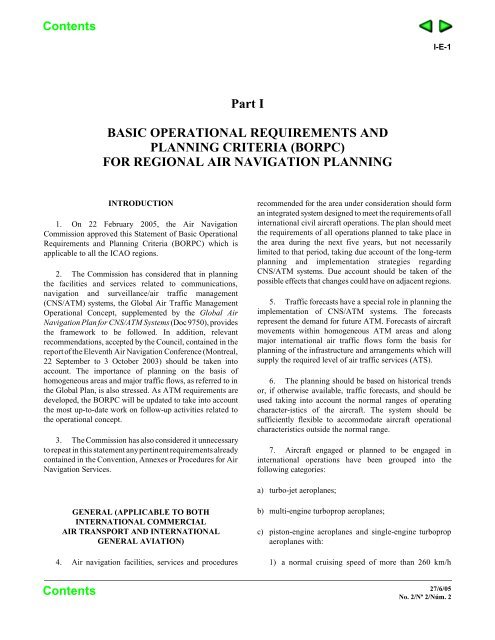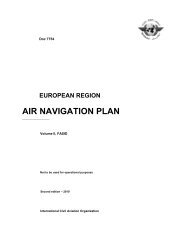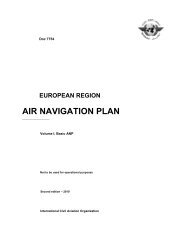introduction - ICAO Public Maps
introduction - ICAO Public Maps
introduction - ICAO Public Maps
Create successful ePaper yourself
Turn your PDF publications into a flip-book with our unique Google optimized e-Paper software.
I-E-1<br />
Part I<br />
BASIC OPERATIONAL REQUIREMENTS AND<br />
PLANNING CRITERIA (BORPC)<br />
FOR REGIONAL AIR NAVIGATION PLANNING<br />
INTRODUCTION<br />
1. On 22 February 2005, the Air Navigation<br />
Commission approved this Statement of Basic Operational<br />
Requirements and Planning Criteria (BORPC) which is<br />
applicable to all the <strong>ICAO</strong> regions.<br />
2. The Commission has considered that in planning<br />
the facilities and services related to communications,<br />
navigation and surveillance/air traffic management<br />
(CNS/ATM) systems, the Global Air Traffic Management<br />
Operational Concept, supplemented by the Global Air<br />
Navigation Plan for CNS/ATM Systems (Doc 9750), provides<br />
the framework to be followed. In addition, relevant<br />
recommendations, accepted by the Council, contained in the<br />
report of the Eleventh Air Navigation Conference (Montreal,<br />
22 September to 3 October 2003) should be taken into<br />
account. The importance of planning on the basis of<br />
homogeneous areas and major traffic flows, as referred to in<br />
the Global Plan, is also stressed. As ATM requirements are<br />
developed, the BORPC will be updated to take into account<br />
the most up-to-date work on follow-up activities related to<br />
the operational concept.<br />
3. The Commission has also considered it unnecessary<br />
to repeat in this statement any pertinent requirements already<br />
contained in the Convention, Annexes or Procedures for Air<br />
Navigation Services.<br />
recommended for the area under consideration should form<br />
an integrated system designed to meet the requirements of all<br />
international civil aircraft operations. The plan should meet<br />
the requirements of all operations planned to take place in<br />
the area during the next five years, but not necessarily<br />
limited to that period, taking due account of the long-term<br />
planning and implementation strategies regarding<br />
CNS/ATM systems. Due account should be taken of the<br />
possible effects that changes could have on adjacent regions.<br />
5. Traffic forecasts have a special role in planning the<br />
implementation of CNS/ATM systems. The forecasts<br />
represent the demand for future ATM. Forecasts of aircraft<br />
movements within homogeneous ATM areas and along<br />
major international air traffic flows form the basis for<br />
planning of the infrastructure and arrangements which will<br />
supply the required level of air traffic services (ATS).<br />
6. The planning should be based on historical trends<br />
or, if otherwise available, traffic forecasts, and should be<br />
used taking into account the normal ranges of operating<br />
character-istics of the aircraft. The system should be<br />
sufficiently flexible to accommodate aircraft operational<br />
characteristics outside the normal range.<br />
7. Aircraft engaged or planned to be engaged in<br />
international operations have been grouped into the<br />
following categories:<br />
a) turbo-jet aeroplanes;<br />
GENERAL (APPLICABLE TO BOTH<br />
INTERNATIONAL COMMERCIAL<br />
AIR TRANSPORT AND INTERNATIONAL<br />
GENERAL AVIATION)<br />
4. Air navigation facilities, services and procedures<br />
b) multi-engine turboprop aeroplanes;<br />
c) piston-engine aeroplanes and single-engine turboprop<br />
aeroplanes with:<br />
1) a normal cruising speed of more than 260 km/h<br />
27/6/05<br />
No. 2/Nº 2/Núm. 2














